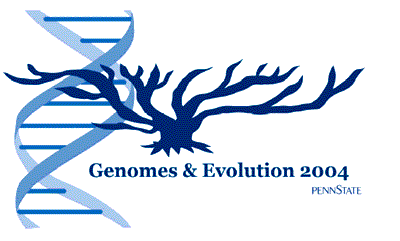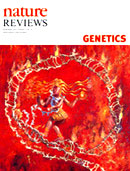A Wordcount for Comparison
 A meeting highlighting "the latest research at the interface of molecular biology and evolution" was held 17-20 June 2004, on the University Park campus of The Pennsylvania State University. Chaired by S. Blair Hedges, titled "Genomes & Evolution 2004," it was the joint annual meeting of the International Society for Molecular Biology and Evolution, and the American Genetic Association (1).
A meeting highlighting "the latest research at the interface of molecular biology and evolution" was held 17-20 June 2004, on the University Park campus of The Pennsylvania State University. Chaired by S. Blair Hedges, titled "Genomes & Evolution 2004," it was the joint annual meeting of the International Society for Molecular Biology and Evolution, and the American Genetic Association (1).
Genomes & Evolution 2004 (2), the book of abstracts from the meeting, is published. Its 152 pages contain close to 400 abstracts, and the Author Index lists approximatey 1,200 names. It is a rich resource. Using Adobe Reader's search function, we searched the book for the frequency of certain terms pertaining to evolution. Among them we found, for example, the following terms|instances — evolution|680; mutation|153; speciation|53; adaptation|29.
 Because the abstract book represents current evolutionary theory, we also searched it for terms pertaining to seven different mechanisms by which new genes are believed to originate. These terms were chosen from a review by Manyuan Long et al., published in Nature Reviews Genetics, in November 2003. The review, "The Origin of New Genes: Glimpses from the Young and Old" (3), lists the seven mechanisms in a table and discusses them at length in the text. We are especially interested in the implication of each mechanism for the standard theory of evolution and for alternatives like ours. Which mechanisms can produce new genetic programs? How do they rank in importance?
Because the abstract book represents current evolutionary theory, we also searched it for terms pertaining to seven different mechanisms by which new genes are believed to originate. These terms were chosen from a review by Manyuan Long et al., published in Nature Reviews Genetics, in November 2003. The review, "The Origin of New Genes: Glimpses from the Young and Old" (3), lists the seven mechanisms in a table and discusses them at length in the text. We are especially interested in the implication of each mechanism for the standard theory of evolution and for alternatives like ours. Which mechanisms can produce new genetic programs? How do they rank in importance?
The standard theory, neodarwinism (ND), maintains that pointwise mutations can write new genetic programs, gradually, on existing DNA. Our theory, cosmic ancestry (CA) holds that new genetic programs must be acquired in large blocks and subsequently pieced together by known processes like recombination and DNA repair. Among the seven listed mechanisms, we observe:
- Five of them exemplify cosmic ancestry's piecing together of large blocks.
- The sixth mechanism, gene duplication (listed 2nd in the table), might exemplify our theory or standard neodarwinism, depending on which other mechanisms accompany it. (Duplication and subsequent pointwise divergence within a narrow range — creating no new genetic programs — is consistent with either theory.)
- Only the seventh mechanism, de novo origination, could be claimed to exemplify neodarwinism. But even in this case, the "previously noncoding region" apparently "originated" with its programmatic meaning already installed. Possibly it is a component of a preexisting program, acquired long ago, awaiting deployment.
As a crude way of measuring the relative importance of the seven mechanisms, we counted the appearance of terms pertaining to each in the new abstract book. The table below displays the results of our search. The two leftmost columns are reproduced verbatim from the table in Long et al.'s 2003 review. Next, the skinny column designates which theory we think each mechanism exemplifies. The right side shows the terms chosen from the review, and the number of times each appears in the 2004 book of abstracts. If this abstract book acurately reflects our current state of knowledge about evolution, and if counting terms is a useful method, we think standard neodarwinism needs a major amendment such as ours.
mechanisms from review:
"The Origin of New Genes..." (2003)
| ND
or
CA
| term counts in abstracts: Genomes & Evolution 2004
|
Exon Shuffling:
ectopic recombination of exons and domains from distinct genes
| ~19% of exons in eukaryotic genes have been formed by exon shuffling
| CA
| exon
shuffling
recombination
domain
| 35
60
68
9
|
Gene Duplication:
classic model of duplication with divergence
| Many duplicates have probably evolved new functions
| ??
| gene duplication
duplicate(*)
divergence
| 43
62
120
|
Retroposition:
new gene duplicates are created in new genomic positions by reverse transcription or other processes
| 1% of human DNA is retroposed to new genomic locations
| CA
| retroposition
reverse transcription
| 7
2
|
Mobile element:
a mobile element, also known as a transposable element (TE), sequence is directly recruited by host genes
| Generates 4% of new exons in human protein-coding genes
| CA
| mobile element
transposable element
recruit(ed/ment)
| 5
28
11
|
Lateral gene transfer:
a gene is laterally (horizontally) transmitted among organisms
| Most often reported in prokaryotes and recently reported in plants
| CA
| gene transfer
horizontal(ly) transfer
lateral(ly) transfer
| 36
13
3
|
Gene fusion/fission:
two adjacent genes fuse into a single gene, or a single gene splits into two genes
| involved in the formation of ~0.5% of prokaryotic genes
| CA
| fusion
fission
| 9
1
|
De novo origination:
a coding region originates from a previously non-coding genomic region
| Rare for whole gene origination; might not be rare for partial gene origination
| ND
??
| de novo
origination
originate(s/d)
| 3
0
7
|
 20 Dec 2021: Chimeric RNAs become genes?! 20 Dec 2021: Chimeric RNAs become genes?!
 ...Evolving Approaches on Studies of Evolution by Gene Duplication by Frédéric J J Chain and Raquel Assis, Genome Biology and Evolution, 23 Jul 2021. ...Evolving Approaches on Studies of Evolution by Gene Duplication by Frédéric J J Chain and Raquel Assis, Genome Biology and Evolution, 23 Jul 2021.
 21 Aug 2016: Can antagonistic evolution compose de novo genes? 21 Aug 2016: Can antagonistic evolution compose de novo genes?
 4 Sep 2015: ...Thousands of transcripts ...which are likely to have originated de novo.... 4 Sep 2015: ...Thousands of transcripts ...which are likely to have originated de novo....  4 Jan 2016. 4 Jan 2016.
 8 Oct 2014: 24 hominoid-specific de novo protein-coding genes were identified. 8 Oct 2014: 24 hominoid-specific de novo protein-coding genes were identified.
 24 Jan 2014: The earliest steps in de novo gene origination remain mysterious. 24 Jan 2014: The earliest steps in de novo gene origination remain mysterious.
 19 Nov 2011: Where do new genes come from? 19 Nov 2011: Where do new genes come from?
 13 Sep 2010: Origins, evolution, and phenotypic impact of new genes 13 Sep 2010: Origins, evolution, and phenotypic impact of new genes
 14 Sep 2009: If we didn't know about life we wouldn't believe it — Richard Dawkins. 14 Sep 2009: If we didn't know about life we wouldn't believe it — Richard Dawkins.
 D. Allan Drummond, Jonathan J. Silberg, et al., "On the conservative nature of intragenic recombination" [abstract], p 5380-5385 v 102, Proc. Natl. Acad. Sci. USA, 12 April 2005. "...Variants created by recombination retain function with a significantly higher probability than those generated by random mutagenesis." D. Allan Drummond, Jonathan J. Silberg, et al., "On the conservative nature of intragenic recombination" [abstract], p 5380-5385 v 102, Proc. Natl. Acad. Sci. USA, 12 April 2005. "...Variants created by recombination retain function with a significantly higher probability than those generated by random mutagenesis."
 28 Feb 2005: Can pre-existing genetic programs be pieced together? 28 Feb 2005: Can pre-existing genetic programs be pieced together?
 John W. Fondon III and Harold R. Garner, "Molecular origins of rapid and continuous morphological evolution" [abstract], Proc. Natl. Acad. Sci. USA, online 13 Dec 2004. "...Molecular explanations for swift, yet topologically conservative morphological evolution." John W. Fondon III and Harold R. Garner, "Molecular origins of rapid and continuous morphological evolution" [abstract], Proc. Natl. Acad. Sci. USA, online 13 Dec 2004. "...Molecular explanations for swift, yet topologically conservative morphological evolution."
 John S. Taylor and Jeroen Raes, "Duplication and Divergence: The Evolution of New Genes and Old Ideas" [abstract], p 615-643 v 38, Annual Review of Genetics, Dec 2004. John S. Taylor and Jeroen Raes, "Duplication and Divergence: The Evolution of New Genes and Old Ideas" [abstract], p 615-643 v 38, Annual Review of Genetics, Dec 2004.
 30 Nov 2004: A Wordcount for Comparison — our announcement of this new page, and a 26 Nov discussion of jingwei and the seven mechanisms. 30 Nov 2004: A Wordcount for Comparison — our announcement of this new page, and a 26 Nov discussion of jingwei and the seven mechanisms.
References
1. Genomes & Evolution 2004, [conference homepage].
2. Genomes & Evolution 2004, [local PDF, 1.3Mb].
3. Manyuan Long, Esther Betrán, Kevin Thornton and Wen Wang, "The Origin of New Genes: Glimpses from the Young and Old" [abstract], doi:10.1038/nrg1204, p 865-875 v 4, Nature Reviews Genetics, Nov 2003.
![]()
|
 A meeting highlighting "the latest research at the interface of molecular biology and evolution" was held 17-20 June 2004, on the University Park campus of The Pennsylvania State University. Chaired by S. Blair Hedges, titled "Genomes & Evolution 2004," it was the joint annual meeting of the International Society for Molecular Biology and Evolution, and the American Genetic Association (1).
A meeting highlighting "the latest research at the interface of molecular biology and evolution" was held 17-20 June 2004, on the University Park campus of The Pennsylvania State University. Chaired by S. Blair Hedges, titled "Genomes & Evolution 2004," it was the joint annual meeting of the International Society for Molecular Biology and Evolution, and the American Genetic Association (1).
 Because the abstract book represents current evolutionary theory, we also searched it for terms pertaining to seven different mechanisms by which new genes are believed to originate. These terms were chosen from a review by Manyuan Long et al., published in Nature Reviews Genetics, in November 2003. The review, "The Origin of New Genes: Glimpses from the Young and Old"
Because the abstract book represents current evolutionary theory, we also searched it for terms pertaining to seven different mechanisms by which new genes are believed to originate. These terms were chosen from a review by Manyuan Long et al., published in Nature Reviews Genetics, in November 2003. The review, "The Origin of New Genes: Glimpses from the Young and Old"